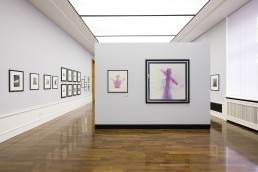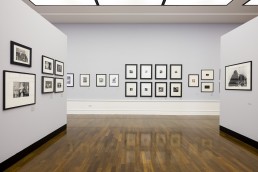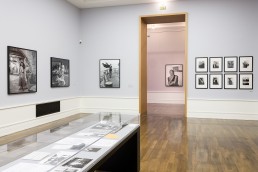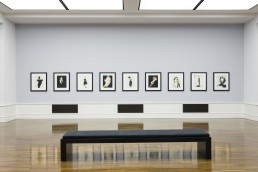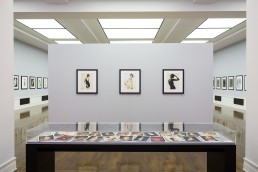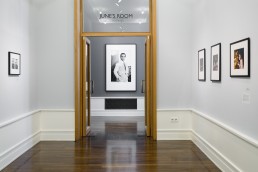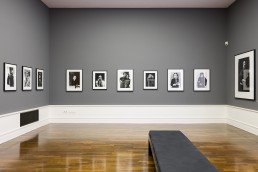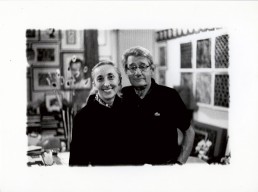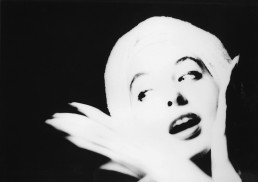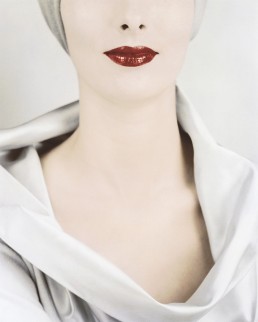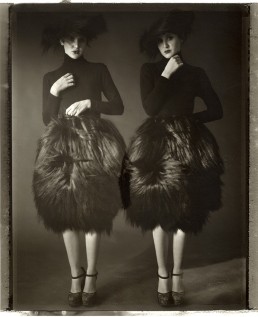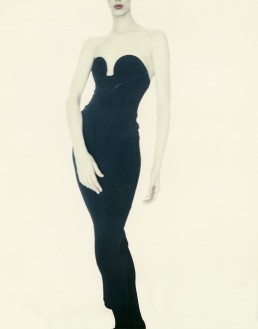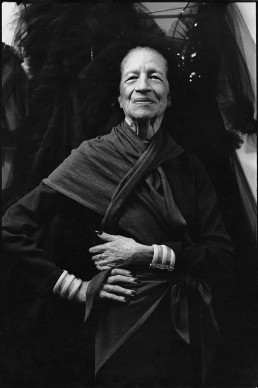An art collection reveals much about its collector, and serves as a kind of self-portrait. This can also be said of Carla Sozzani’s collection, which sheds light on her aesthetic preferences and friendships.
Carla Sozzani, former editor-in-chief of Italian Elle and Vogue, has collected photographs for many years. Since 1990, she has also exhibited such works in her Milan gallery in close cooperation with internationally renowned photographers – including Helmut Newton four times, Ritratti di donna in 1993, Impressions, Polaroids in 1996, Us and Them in 1999, together with Alice Springs, and Yellow Press in 2003. The personal friendship between Sozzani and Newton led to the current presentation of her multifaceted photography collection at the Helmut Newton Foundation: Between Art & Fashion not only presents numerous icons, it also contains some surprises. Following venues in Paris and Switzerland it is now being shown in a new arrangement for the first time in Germany. Some of the photographers are represented with only a single print, others with a small group of works.
On display in June’s Room, on the occasion of the 95th birthday of June Newton, who worked under the name Alice Springs, are about 30 previously unseen portraits, selected from the foundation’s collection.
Selected Works
Between Art & Fashion
Matthias Harder
Carla Sozzani, former editor-in-chief of the Italian Elle and Vogue magazines, has collected photographs for many years. Since 1990, she has also exhibited these works at her gallery in Milan, in close cooperation with numerous internationally renowned photographers. Four of these shows were dedicated to the work of Helmut Newton, in 1993 (Ritratti di donna), 1996 (Impressions, Polaroids), 1999 (Us and Them, together with Alice Springs), and in 2003 (Yellow Press).
Galleria Carla Sozzani continues to be a central part of her pioneering concept store, 10 Corso Como. Launched in 1991 in the heart of Milan, it now has branches in China, Korea, and the USA. Since 2016, the gallery has been under the patronage of the Fondazione Sozzani. Over the years, 10 Corso Como has strongly influenced its immediate surroundings near the Garibaldi railway station in Milan, serving as an epicenter of “radical trends” most recently manifested in spectacular new architecture, such as Stefano Boeri’s Bosco Verticale. Since opening her gallery 28 years ago, Carla Sozzani has hosted hundreds of photography exhibitions there, featuring the likes of Annie Leibovitz, Sarah Moon, Paolo Roversi, David Bailey, Hiro, and David LaChapelle. Architecture and design exhibitions are also held regularly, and have included the works of Carlo Mollino, Verner Panton, and Yayoi Kusama. The gallery has also showcased fashion by Pierre Cardin, Courrèges, and Paco Rabanne, to name a few. In the adjoining book store, which repeatedly ranks amongst the most beautiful bookshops in the world, visitors can find thematically relevant publications on architecture, design, graphics, fashion, and above all photography, also issued by the gallery’s own publishing house, Carla Sozzani Editore. 10 Corso Como is an ideal fusion of art and commerce – just like the photography of Helmut Newton.
The close friendship between Carla Sozzani and Helmut Newton led her to show his work in Milan, and now leads to the first-ever presentation of Sozzani’s multifaceted collection in Germany, at the Helmut Newton Foundation. For the exhibition Between Art & Fashion, more than 200 photographs were selected from her collection, which comprises nearly 1,000 photographs. In addition to fashion it includes experimental photographs by Berenice Abbott and Duane Michals, nudes by Francesca Woodman and Daidō Moriyama, and still lifes by Man Ray and William Klein. Many of the photographs in the collection are figurative and the figures are mostly female – thus coming full circle to fashion, Carla Sozzani’s other passion. Time and again, the uniqueness of a fashion image, visualizing and defining individuality and zeitgeist, finds pure expression in the collected works, for instance by Lillian Bassman, Erwin Blumenfeld, Steven Meisel, and Jean-Baptiste Mondino.
An art collection reveals much about its collector, and serves as a kind of self-portrait. This can also be said of Carla Sozzani’s collection, which sheds light on her aesthetic preferences and friendships. Unlike institutional collectors such as photography museums, her aim is not to establish an encyclopedic trove of international photographic art, but to approach it in a highly individual way. Photography for her is a means of communication, reproduced in fashion magazines or as collected photographic prints; we can sense Sozzani’s special intuition for outstanding individual works and series. Over the course of many years a diverse collection has thus come into being, less systematically than subjectively. With its focus on classic black-and-white photography, it offers a look back into a bygone era. This significant and valuable private collection is usually kept just behind the exhibition rooms of Sozzani’s gallery, in her spacious office. The framed pictures tightly line its walls all the way up to the ceiling; some of these are now on display in Berlin. While its main emphasis is on people and fashion, the collection also includes images of plants, early travel photographs, and unconventional nudes. The transition from fashion photography to nude photography is fluid – as we know from Helmut Newton and his famous series, Naked and Dressed. Clothes cover the bare bodies of their models; designers play with allure, elegance, and eroticism in their creations; and photographers are commissioned to convincingly visualize fashion’s seductive power at play.
Between Art & Fashion, originally initiated as an exhibition by Azzedine Alaïa, features numerous iconic as well as surprising images. Following presentations in Paris and Switzerland it is now being shown in a new configuration at the Helmut Newton Foundation in Berlin. Some photographers are represented with a single work; for others, there is a small assortment of images. In Berlin, generous space is dedicated to the collaborations between Carla Sozzani and Paolo Roversi, Sarah Moon, Bruce Weber, and Helmut Newton, with original prints, work photos, and contact sheets from the joint fashion shoots on display. Carla Sozzani herself has often modeled for photographers, such as Dominique Issermann, who portrayed her at Azzedine Alaïa’s, for Bruce Weber, who has portrayed her several times with jewelry designs by her partner Kris Ruhs, and for Helmut Newton and Alice Springs; these portraits are also part of the exhibition. The selection does not aim to be exhaustive, but instead highlights authenticity and visualization, and the quality of autonomous and representative images. These have been chosen for their thematic resonance with the exhibition venue in Berlin and its orientation towards fashion, nude, and portrait photography.
In June’s Room, the Helmut Newton Foundation presents some 30 portraits by June Newton, who worked under the name Alice Springs, on the occasion of her 95th birthday. Some of these photographs are being shown for the first time, and in the context of the Sozzani collection, are mainly of artists, photographers, and fashion designers.
Alice Springs started working in the 1970s on her own photographic oeuvre, which has also often been featured at the Helmut Newton Foundation. The artists, actors, and musicians she has portrayed reads like a who’s who of the international cultural scene from the past 40 years on either side of the Atlantic – from Yves Saint Laurent and Karl Lagerfeld to Billy Wilder and Diana Vreeland, and even the Hell’s Angels. Although many of her subjects are from the jet set, social status has never been a priority for Alice Springs. Her work included magazine commissions as well as her own independent projects. Her keen ability to both reveal and penetrate a person’s façade might be traced back to her solid foundation in acting. In her photographic encounters with a person, she often closes in on their face, framing them in a tight bust or waist shot. There are seldom studio shots; most of the portraits were taken in public spaces or at the protagonist’s home, often using natural light. Alice Springs succeeds not only in capturing her subject’s outer appearance, but also their aura. The wordless dialogue that leads to these extraordinary portraits often seems to stem from a sense of spiritual kinship.
